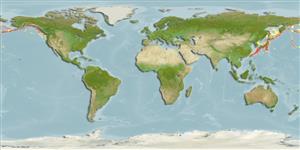Environment: milieu / climate zone / depth range / distribution range
Ecología
marino bentopelágico; rango de profundidad 612 - 1700 m (Ref. 50550). Temperate; 66°N -
North Pacific: Pusan, Korea north (outside the Sea of Okhotsk) to Providence Bay in the Anadyr Gulf of the Bering Sea, throughout the Aleutian Basin and islands, and southeast to Mathieson Channel, British Columbia, Canada.
Tamaño / Peso / Age
Maturity: Lm ? range ? - ? cm
Max length : 41.0 cm TL macho / no sexado; (Ref. 56527); peso máximo publicado: 2.3 kg (Ref. 56527)
Espinas dorsales (total): 0; Radios blandos dorsales (total): 8-9; Espinas anales 0; Radios blandos anales: 7 - 9. Brownish gray with dark spots dorsally, muddy gray ventrally. Caudal fin rounded; pectoral fins large and broadly based; pelvic fins modified to form a clinging disc with a thickened margin on the ventral surface of the body (Ref. 6885). Skin naked without scales and tubercles. First dorsal fin completely embedded under the skin. Disk rudimentary in young, well developed in adults (Ref. 43939).
Males are said to guard the eggs (Ref. 6885). Migrate to spawn in littoral waters of Bering Sea in December-June (Ref. 43939).
Life cycle and mating behavior
Madurez | Reproducción | Puesta | Huevos | Fecundidad | Larva
Eschmeyer, W.N., E.S. Herald and H. Hammann, 1983. A field guide to Pacific coast fishes of North America. Boston (MA, USA): Houghton Mifflin Company. xii+336 p. (Ref. 2850)
IUCN Red List Status (Ref. 130435)
Threat to humans
Harmless
Human uses
Más información
ReferenciasAcuiculturaPerfil de acuiculturaRazasGenéticaElectrophoresesheritabilidadEnfermedadesProcesamientoNutrientsMass conversion
ColaboradoresImágenesStamps, Coins Misc.SonidosCiguateraVelocidadTipo de nataciónSuperficie branquialOtolitosCerebrosVisión
Herramientas
Special reports
Download XML
Fuentes de Internet
Estimates based on models
Preferred temperature (Ref.
123201): 2.3 - 4.6, mean 2.8 °C (based on 159 cells).
Phylogenetic diversity index (Ref.
82804): PD
50 = 1.0000 [Uniqueness, from 0.5 = low to 2.0 = high].
Bayesian length-weight: a=0.01995 (0.00906 - 0.04395), b=3.01 (2.83 - 3.19), in cm total length, based on all LWR estimates for this body shape (Ref.
93245).
Nivel trófico (Ref.
69278): 3.7 ±0.38 se; based on food items.
Resiliencia (Ref.
120179): Medio, población duplicada en un tiempo mínimo de 1.4-4.4 años (Preliminary K or Fecundity.).
Fishing Vulnerability (Ref.
59153): Low to moderate vulnerability (31 of 100).
